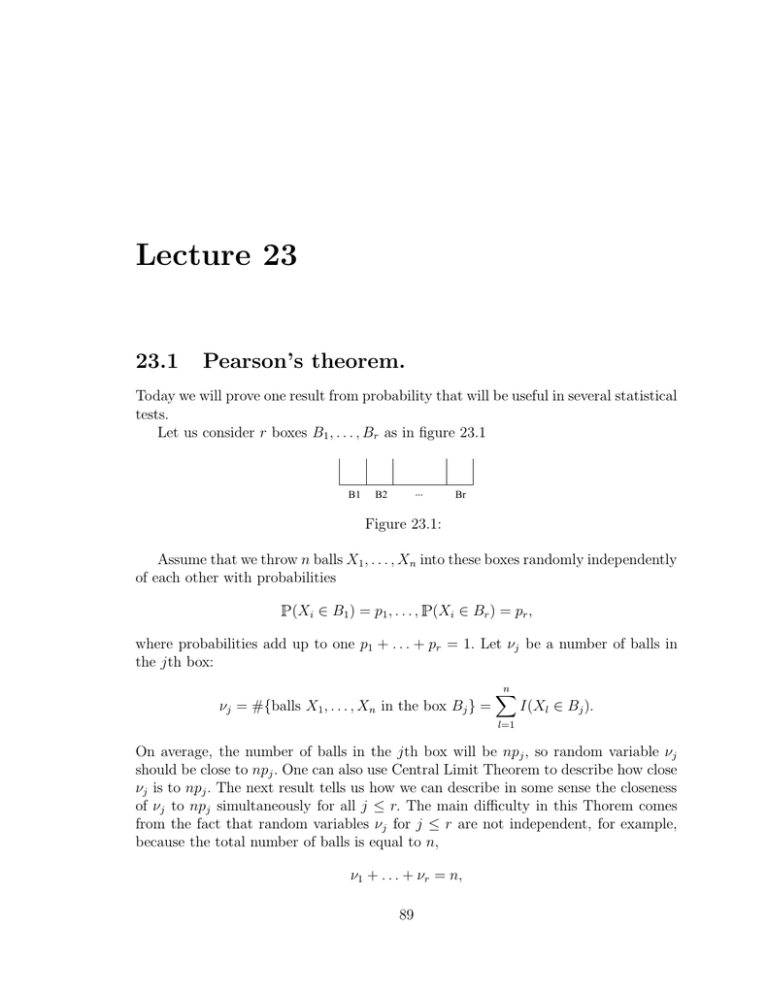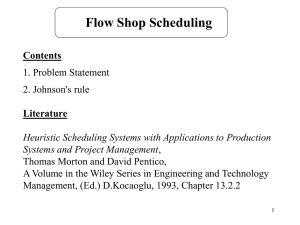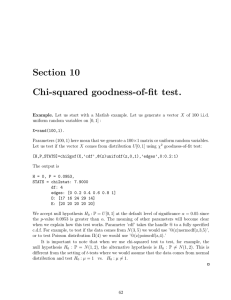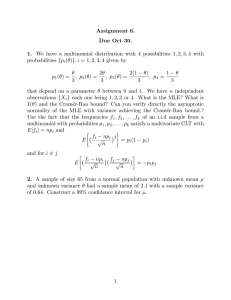Lecture 23 23.1 Pearson’s theorem.
advertisement

Lecture 23
23.1
Pearson’s theorem.
Today we will prove one result from probability that will be useful in several statistical
tests.
Let us consider r boxes B1 , . . . , Br as in figure 23.1
B1
...
B2
Br
Figure 23.1:
Assume that we throw n balls X1 , . . . , Xn into these boxes randomly independently
of each other with probabilities
(Xi ∈ B1 ) = p1 , . . . , (Xi ∈ Br ) = pr ,
where probabilities add up to one p1 + . . . + pr = 1. Let νj be a number of balls in
the jth box:
νj = #{balls X1 , . . . , Xn in the box Bj } =
n
X
l=1
I(Xl ∈ Bj ).
On average, the number of balls in the jth box will be npj , so random variable νj
should be close to npj . One can also use Central Limit Theorem to describe how close
νj is to npj . The next result tells us how we can describe in some sense the closeness
of νj to npj simultaneously for all j ≤ r. The main difficulty in this Thorem comes
from the fact that random variables νj for j ≤ r are not independent, for example,
because the total number of balls is equal to n,
ν1 + . . . + νr = n,
89
90
LECTURE 23.
i.e. if we know these numbers in n − 1 boxes we will automatically know their number
in the last box.
Theorem. We have that the random variable
r
X
(νj − npj )2
→ χ2r−1
np
j
j=1
converges in distribution to χ2r−1 distribution with (r − 1) degrees of freedom.
Proof. Let us fix a box Bj . The random variables
I(X1 ∈ Bj ), . . . , I(Xn ∈ Bj )
that indicate whether each observation Xi is in the box Bj or not are i.i.d. with
Bernoully distribution B(pj ) with probability of success
I(X1 ∈ Bj ) =
(X1 ∈ Bj ) = pj
and variance
Var(I(X1 ∈ Bj )) = pj (1 − pj ).
Therefore, by Central Limit Theorem we know that the random variable
Pn
νj − npj
l=1 I(Xl ∈ Bj ) − npj
p
p
=
npj (1 − pj )
npj (1 − pj )
Pn
l=1 I(Xl ∈ Bj ) − n
√
=
→ N (0, 1)
nVar
converges to standard normal distribution. Therefore, the random variable
p
νj − npj
→ 1 − pj N (0, 1) = N (0, 1 − pj )
√
npj
converges to normal distribution with variance 1 − pj . Let us be a little informal and
simply say that
νj − npj
→ Zj
√
npj
where random variable Zj ∼ N (0, 1 − pj ).
We know that each Zj has distribution NP
(0, 1 − pj ) but, unfortunately, this does
not tell us what the distribution of the sum
Zj2 will be, because as we mentioned
above r.v.s νj are not independent and their correlation structure will play an important role. To compute the covariance between Zi and Zj let us first compute the
covariance between
νj − npj
νi − npi
and √
√
npi
npj
91
LECTURE 23.
which is equal to
νi − npj νj − npj
1
= √
( νi νj − νi npj − νj npi + n2 pi pj )
√
√
npi
npj
n pi pj
1
1
= √
( νi νj − npi npj − npj npi + n2 pi pj ) = √
( νi νj − n2 pi pj ).
n pi pj
n pi pj
To compute νi νj we will use the fact that one ball cannot be inside two different
boxes simultaneously which means that
I(Xl ∈ Bi )I(Xl ∈ Bj ) = 0.
(23.1)
Therefore,
n
X
νi νj =
l=1
=
X
l=l0
I(Xl ∈ Bi )
n
X
l0 =1
I(Xl0 ∈ Bj ) =
I(Xl ∈ Bi )I(Xl0 ∈ Bj ) +
X
l6=l0
X
l,l0
I(Xl ∈ Bi )I(Xl0 ∈ Bj )
I(Xl ∈ Bi )I(Xl0 ∈ Bj )
{z
}
this equals to 0 by (23.1)
= n(n − 1) I(Xl ∈ Bj ) I(Xl0 ∈ Bj ) = n(n − 1)pi pj .
|
Therefore, the covariance above is equal to
1 √
2
n(n − 1)pi pj − n pi pj = − pi pj .
√
n pi pj
To summarize, we showed that the random variable
r
X
(νj − npj )2
j=1
npj
→
r
X
Zj2 .
j=1
where random variables Z1 , . . . , Zn satisfy
Zi2 = 1 − pi and covariance
√
Z i Zj = − p i p j .
To prove the Theorem it remains to show that this covariance structure of the sequence
2
of Zi ’s will imply that their sum of squares
P 2 has distribution χr−1 . To show this we
will find a different representation for
Zi .
Let g1 , · · · , gr be i.i.d. standard normal sequence. Consider two vectors
√
√
~g = (g1 , . . . , gr ) and p~ = ( p1 , . . . , pr )
92
LECTURE 23.
√
√
and consider a vector ~g − (~g · p~)~
p, where ~g · p~ = g1 p1 + . . . + gr pr is a scalar product
of ~g and p~. We will first prove that
~g − (~g · p~)~
p has the same joint distribution as (Z1 , . . . , Zr ).
(23.2)
To show this let us consider two coordinates of the vector ~g − (~g · p~)~
p:
r
X
√ √
i : gi −
gl pl pi
th
l=1
and j
th
r
X
√ √
: gj −
gl pl pj
l=1
and compute their covariance:
r
r
X
X
√ √ √ √ gi −
gl pl pi gj −
gl pl pj
l=1
l=1
n
X
√ √
√ √
√ √
√
√
√
pl pi pj = −2 pi pj + pi pj = − pi pj .
= − pi pj − pj pi +
l=1
Similarly, it is easy to compute that
r
X
√ √ 2
gi −
gl pl pi = 1 − p i .
l=1
This proves (23.2), which provides us with another way to formulate the convergence,
namely, we have
r
r X
X
νj − npj 2
→
(ith coordinate)2
√
np
j
i=1
j=1
where we consider the coorinates of the vector ~g −(~g · p~)~
p. But this vector has a simple
geometric interpretation. Since vector p~ is a unit vector:
r
r
X
√ 2 X
|~p| =
( pi ) =
pi = 1,
2
l=1
l=1
~1 = (~
vector V
p · ~g )~
p is the projection of vector ~g on the line along p~ and, therefore,
~
vector V2 = ~g − (~
p · ~g )~
p will be the projection of ~g onto the plane orthogonal to p~, as
shown in figures 23.2 and 23.3.
Let us consider a new orthonormal coordinate system with the last basis vector
(last axis) equal to p~. In this new coordinate system vector ~g will have coordinates
~g 0 = (g10 , . . . , gr0 ) = ~g V
93
LECTURE 23.
p
V1
V2
θ
g
Figure 23.2: Projections of ~g .
(*)
p
gr’
gr
g
90o
Rotation
g2
(*)’
V2
g2’
g1
g1’
Figure 23.3: Rotation of the coordinate system.
obtained from ~g by orthogonal transformation V that maps canonical basis into this
new basis. But we proved a few lectures ago that in that case g10 , . . . , gr0 will also be
~2 = ~g − (~
i.i.d. standard normal. From figure 23.3 it is obvious that vector V
p · ~g )~
p in
the new coordinate system has coordinates
0
(g10 , . . . , gr−1
, 0)
and, therefore,
r
X
0
(ith coordinate)2 = (g10 )2 + . . . + (gr−1
)2 .
i=1
0
But this last sum, by definition, has χ2r−1 distribution since g10 , · · · , gr−1
are i.i.d.
standard normal. This finishes the proof of Theorem.






